Effective hunting accuracy should be every hunter’s goal. Hunting accuracy and target accuracy are different animals. It’s not enough to pound a bulls-eye or even the kill zone of a 3-D target. What matters is making a lethal shot 100% of the time. Hunting has no referees so it is up to the individual to assure he can launch with lethality every time. Here’s how.
Begin with the End in Mind
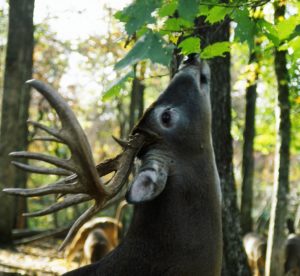 Are you after meat for the freezer; a known whitetail buck; or maybe a Western adventure for mule deer and elk? Each of these animals requires specific gear and you want to begin well in advance of your hunt. Are you considering a new bow, perhaps the new Xpedition Mountaineer for example? I mention this model because it’s designed to deliver optimal speed (340 fps), weighs less than four pounds, and has a very forgiving brace height to provide smooth draw and efficient power.
Are you after meat for the freezer; a known whitetail buck; or maybe a Western adventure for mule deer and elk? Each of these animals requires specific gear and you want to begin well in advance of your hunt. Are you considering a new bow, perhaps the new Xpedition Mountaineer for example? I mention this model because it’s designed to deliver optimal speed (340 fps), weighs less than four pounds, and has a very forgiving brace height to provide smooth draw and efficient power.
What about broadheads? Personally, I’m testing several of the new hybrid expandable heads. Typically the fly like target point and now deliver cut-on-contact lethality in addition to an additional cutting blade. So far I’ve used Grim Reaper, Veteran, and Bloodsport. If you plan to hunt elk or other large game animals you may wish to stay with a fixed head which usually penetrates further.
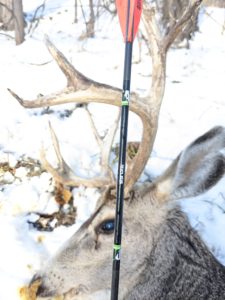
Arrows also are critical. You want to have arrows that are cut to your draw length and tailored to your bow. Too much or too little spine will prevent your bow from operating at top efficiency. It’s critical that your hunting bow and arrows are tuned and matched so that you have confidence with each release. If you’d like arrows built to your specs instead of buying then at a big-box store, consider the Brandon and Caleb Hobbs who operate DNA Archery in Colorado. They are easy to talk to and will provide the exact arrow you need.
Perfect Practice Makes Perfect
For archers, effective hunting accuracy begins with muscle tone. Unless you shoot year-round, you will need up to a month for your muscles to strengthen. You want to be able to draw your bow without struggle or tremble and without raising it overhead. As an animal steps into range, you should bring the bow to your anchor point smoothly with a solid anchor.
The first step in a practice regimen is tightening groups. When you can touch fletch consistently at 30 yards, you are there. Now move to simulated shooting scenarios that closely approximate hunting conditions. If you shoot from an elevated stand, practice that way. If you will be walking and stalking, set your target so that you must shoot under, over, and around objects. The last stage is shooting on a 3-D target from those same difficult angles. There is probably a 3-D course near you and a visit or two will quickly reveal your readiness.
Master Distance
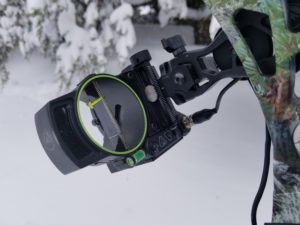
I’ve hunted in my home state of Maryland for almost 50 years and the biggest buck I’ve ever seen walked toward me and I waited in a tree stand. The buck had been spooked by a doe I shot earlier and I had to rattle and grunt for nearly 20 minutes to get him into range. The buck stopped broadside at 42 yards, but I got pin confusion and shot for 32, sending the arrow just under his chest. Oh, the agony.
Because ranging an animal is so important and can be nerve-wracking at the moment of truth, consider using a Burris Oracle that uses a bright aiming pin and calculates the distance for you. Burris has been making range-finding scopes for years so this is not a new technology for them.
Seek and Advantage
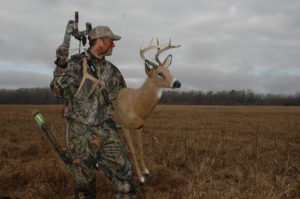
Successful hunters often use lures or distractions to give them an edge. Sure you still need effective hunting accuracy, yet there is less chance of a buck seeing you or dodging hour arrow if it is distracted. Mock scrapes, estrous lures, and small buck decoys are a great way to bring a buck into slam-dunk range while allowing you to draw aim and release undetected.
Ground blinds are often overlooked for deer hunting, yet they allow you to see a deer approaching, move into the best shooting position, and draw your bow without being seen. Additionally, you will shoot from a blind at ground level which makes aiming easier than from an elevated stand.
Time for Success-
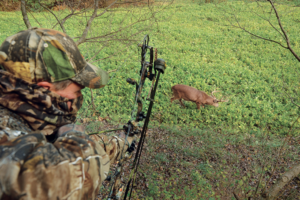
Archers are blessed with a long hunting season and it’s important to keep practicing as the weeks go by. Shoot enough to keep your groups tight and muscle tone. When you hunt can be as important as where. Research has shown that success is optimized the first time you hunt a stand. The more time you go there, the more scent you leave and the less deer you will see. Morning hunts can be good, but can you get to your ambush spot without spooking deer? For many locations, evening stands up the odds. We all love the rut, yet at its peak, big bucks will be locked on a doe and their patterns are erratic. Better to concentrate on the pre-rut period when bucks are visiting scrapes and anxious to approach grunts, rattles, and challenges.
Master your effective hunting accuracy, take the above steps and your freezer will fill.



















![The Best Deer Camp Chili [VIDEO] Deer Chili Ingredients, Tomatoes, Chili Spices](/wp-content/uploads/2015/10/Deer-Chili-Deer-Camp-Recipe-218x150.jpg)
![How to Call Elk Early in the Season [VIDEO]](/wp-content/uploads/2016/08/byers003-218x150.jpg)

![ExpeditionSunset-4[43255]](/wp-content/uploads/2020/08/ExpeditionSunset-443255.jpg)


![Idiots Disturb Hunter: How Would You Have Handled It? [VIDEO]](/wp-content/uploads/2015/10/DSC00110-e1474487693878-100x70.jpg)
![Albino Buck Shocked to Shed His Antlers [VIDEO]](/wp-content/uploads/2015/10/AlbinoDeer-100x70.jpg)